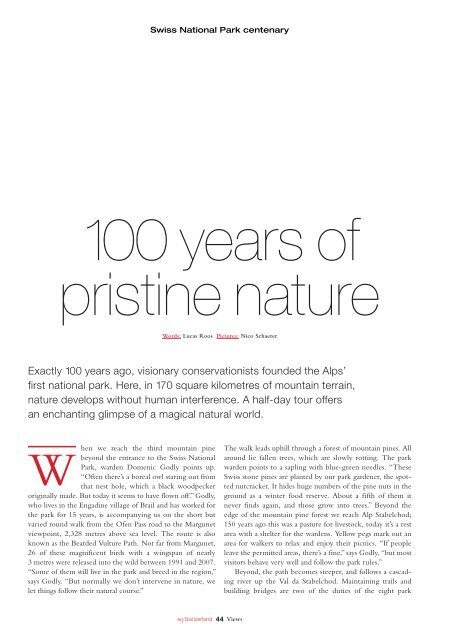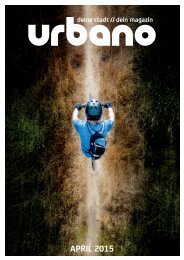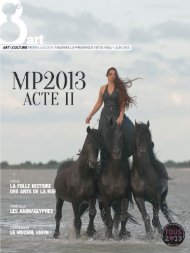mySwitzerland
In the high mountains, where the air is pure and thin, one breathes more freely and feels lighter in body and brighter of mind.” Thus wrote the philosopher Jean-Jacques Rousseau. And he was absolutely right. On a mountaintop, everyday stresses seem insignificant: you feel on top of the world! The views from Switzerland’s high summits are heavenly. Each peak – from the Rigi to the Säntis, from Muottas Muragl to the Schilthorn – reveals a breathtaking natural landscape with its own unique charm. Our new holiday magazine gives you a preview of what to expect when you visit, and shows how you can reach the finest viewpoints easily with the help of spectacular cog railways, cable cars and funiculars. Switzerland’s magnificent natural landscapes thrill and inspire countless visitors. Discover for yourself the magic of our mountains, glaciers, forests and lakes – and experience natural highs that you’ll never forget. Welcome to Switzerland: we look forward to your visit!
In the high mountains, where the air is pure and thin, one breathes more freely
and feels lighter in body and brighter of mind.” Thus wrote the philosopher
Jean-Jacques Rousseau. And he was absolutely right. On a mountaintop,
everyday stresses seem insignificant: you feel on top of the world!
The views from Switzerland’s high summits are heavenly. Each peak – from the
Rigi to the Säntis, from Muottas Muragl to the Schilthorn – reveals a breathtaking
natural landscape with its own unique charm. Our new holiday magazine gives
you a preview of what to expect when you visit, and shows how you can reach
the finest viewpoints easily with the help of spectacular cog railways, cable cars
and funiculars.
Switzerland’s magnificent natural landscapes thrill and inspire countless visitors.
Discover for yourself the magic of our mountains, glaciers, forests and lakes –
and experience natural highs that you’ll never forget.
Welcome to Switzerland: we look forward to your visit!
Create successful ePaper yourself
Turn your PDF publications into a flip-book with our unique Google optimized e-Paper software.
Swiss National Park centenary<br />
100 years of<br />
pristine nature<br />
Words: Lucas Roos Pictures: Nico Schaerer<br />
Exactly 100 years ago, visionary conservationists founded the Alps’<br />
first national park. Here, in 170 square kilometres of mountain terrain,<br />
nature develops without human interference. A half-day tour offers<br />
an enchanting glimpse of a magical natural world.<br />
When we reach the third mountain pine<br />
beyond the entrance to the Swiss National<br />
Park, warden Domenic Godly points up.<br />
“Often there’s a boreal owl staring out from<br />
that nest hole, which a black woodpecker<br />
originally made. But today it seems to have flown off.” Godly,<br />
who lives in the Engadine village of Brail and has worked for<br />
the park for 15 years, is accompanying us on the short but<br />
varied round walk from the Ofen Pass road to the Margunet<br />
viewpoint, 2,328 metres above sea level. The route is also<br />
known as the Bearded Vulture Path. Not far from Margunet,<br />
26 of these magnificent birds with a wingspan of nearly<br />
3 metres were released into the wild between 1991 and 2007.<br />
“Some of them still live in the park and breed in the region,”<br />
says Godly. “But normally we don’t intervene in nature, we<br />
let things follow their natural course.”<br />
The walk leads uphill through a forest of mountain pines. All<br />
around lie fallen trees, which are slowly rotting. The park<br />
warden points to a sapling with blue-green needles. “These<br />
Swiss stone pines are planted by our park gardener, the spotted<br />
nutcracker. It hides huge numbers of the pine nuts in the<br />
ground as a winter food reserve. About a fifth of them it<br />
never finds again, and those grow into trees.” Beyond the<br />
edge of the mountain pine forest we reach Alp Stabelchod;<br />
150 years ago this was a pasture for livestock, today it’s a rest<br />
area with a shelter for the wardens. Yellow pegs mark out an<br />
area for walkers to relax and enjoy their picnics. “If people<br />
leave the permitted areas, there’s a fine,” says Godly, “but most<br />
visitors behave very well and follow the park rules.”<br />
Beyond, the path becomes steeper, and follows a cascading<br />
river up the Val da Stabelchod. Maintaining trails and<br />
building bridges are two of the duties of the eight park<br />
<strong>mySwitzerland</strong> 44 Views

















